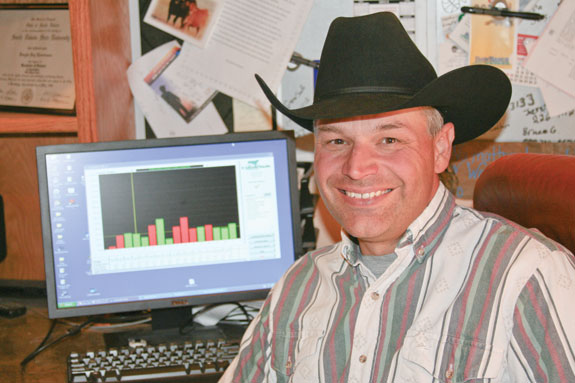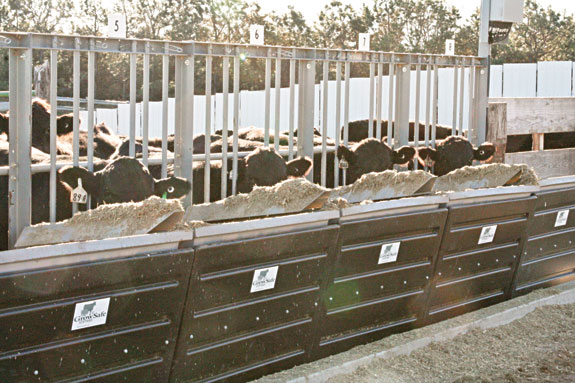And because they also sell Gelbvieh, Angus and Balancer seedstock, Thorstenson would like to be able to pass feed efficiency on to his bull-buying customers.
Now with the help of new technology, he is moving toward that goal.
Thorstenson and his family installed a GrowSafe Residual Feed Intake (RFI) system on their Selby, South Dakota ranch in July 2009. Using electronic identification, the system is able to track every pound of feed each individual animal consumes in about a 90-day period. From that data, an RFI value can be calculated for each animal – giving an indication of which cattle gain efficiently and which are less efficient and require more feed for a pound of gain.
Thorstenson explains that a low RFI is desirable and indicates an animal is more efficient. “It’s kind of like a golf score, you want a negative number,” Thorstenson says.
According to GrowSafe, university research has shown that low-RFI animals consume on average 3.3 to 5.5 pounds less feed per day than high-RFI animals with similar growth performance and carcass characteristics, which can lead to a significant savings in feed costs and is exactly what Thorstenson is aiming for.

Thorstenson adds, “Research indicates that progeny sired by low-RFI bulls will finish for $50 to $70 per head less. That’s profit and loss on a set of steers in today’s cattle industry.” As an example from the data gathered on bulls from his own herd to date, the most efficient bull ate 4.4 pounds of feed to produce a pound of beef and the least efficient ate 12 pounds of feed to produce a pound of beef.
“Take that times the 150 calves a bull sires in his lifetime, and there is real value to this information,” Thorstenson says.
Moreover, Thorstenson says that from a cow perspective, research indicates that in comparing high-efficiency and low-efficiency cattle, there is no impact on breed-back, birthweight, milk production or weaning weight. The only difference is the amount of feed they ate. “So if everything else is equal, which one do you want in your pasture?” asks Thorstenson.
Specifically, a 2008 Montana State University study with 120 2-year-old heifers found no differences in calving scores, percent cycling at bull turnout, or pregnancy rate between cows with high and low dry matter intake.
“So far there have not been effects on reproductive efficiency,” states MSU Extension beef specialist John Paterson.
As well, MSU research indicates low-RFI cows consumed an average of 10 pounds per day less than high-RFI cows, with feed conversion 28.6 percent lower for low-RFI cows compared to high-RFI cows. Moreover, cows determined to be high-RFI or low-RFI did not differ in cow bodyweight at calving, calf birthweight, pre-weaning ADG, or adjusted 205-day weight.
Paterson adds, “We have a study comparing cows over three lactations to determine if RFI is consistent. Over the first two lactations, the correlation was .70, which was pretty encouraging. We plan to re-evaluate the cows when in their fourth lactation.”
Paterson surmises, “This technology is helping answer many questions on an individual basis rather than a group basis.”

How the system works
Developed by a Canadian company, the GrowSafe bunk system includes an electronic scale that weighs every pound of feed an individual animal consumes. An electronic ear tag is inserted into each animal on test and an electronic antenna identifies the animal each time its head is in the individual feedbunk. Cattle are on test for a 90-day period, with each animal’s weight recorded two consecutive days before and after the test to ensure accurate starting and ending weights. And individual animal weights are taken two to three times during the test period as well.
The Thorstensons installed a 16-bunk system that allows 128 head of cattle to be feed-efficiency tested at a time. Their GrowSafe system is one of approximately 30 in place across the U.S., including several currently utilized in university and feedlot settings.
The system is monitored by GrowSafe in Canada through Internet technology. This monitoring allows the owners to know immediately if one of the bunks isn’t working properly or if an animal loses an identification tag so problems can be fixed quickly to save the data.
Based on feed consumption, a drop in intake can also alert Thorstenson to health issues. “We can identify which calves are eating less feed than normal, and we can treat them long before we would have visually noticed they were sick,” Thorstenson says.
At the end of the 90-day test period, the data generated by monitoring the feed consumption of each animal are then converted into results that identify whether the animal is above or below the average of the contemporary group in its feed efficiency.
Thorstenson finds the data generated very intriguing and telling. A set of bulls coming off test this fall indicated that the majority were eating about 2,100 pounds of feed during the 90-day period, but some bulls were eating 1,450 pounds of feed and some were consuming 3,000 pounds. “There is way more variation than you think,” says Thorstenson. He was impressed by one bull on the test that ate 1,900 pounds and was still one of the heavier bulls in the group.
Presently, Thorstenson is putting two groups of bulls through the test from August through January. Their RFI data are then available for every bull offered in the Thorstensons’ annual production sale in March. Last year was the first year they were able to offer the information, and Thorstenson acknowledges that bulls with a negative RFI – indicating they were more efficient – sold well.
Montana State’s Paterson added that MSU research conducted at the Midland Bull Test at Columbus, Montana, indicates ranchers are willing to pay a premium for a bull with a negative RFI. For every one-pound decrease in RFI, buyers were willing to pay an additional $125 in the MSU study.
In addition to his bulls, Thorstenson has put a set of about 130 heifers through the 90-day test period, and says he is eager to follow their progeny. He will test heifers again this spring.
Influencing the cowherd
Thorstenson says his ultimate goal with the efficiency data being gleaned from the GrowSafe system is to identify the sire groups that are working well and concentrate on those sires to add efficiency to his own herd and help customers benefit from efficiency as well.
He explains that RFI is a trait that is 40 percent heritable, meaning it has potential to make a big influence on a herd’s genetics. Thorstenson says, “By incorporating feed efficiency data into the herd bull selection process and then keeping daughters of that sire for his herd, a producer can make his cowherd more efficient and cut hay costs and pasture costs, which means keeping more profit.”
More research is needed in the area of RFI and feed efficiency selection, but Thorstenson is optimistic. He points out, “It can take a lot of acres to run a cow, so if you can get rid of the 10 to 20 percent in your herd that are eating more and improve efficiency, you may be able to increase your stocking rate and have more calves to sell.”
Thorstenson acknowledges that installing the GrowSafe system was a huge expense. Each individual bunk costs about $10,000, with bunks coming in sets of eight. Cost per bunk is reduced with a larger system. For instance, a 16-bunk system has a lower cost/bunk than an eight-bunk system. Overall, Thorstenson considers it an investment worth the cost, and believes the information it provides will pay off.
“We’re running 800 cows, so if we can improve efficiency by 15 to 20 percent, that alone will pay for the system over the next several years.”
That said, he’s not throwing the baby out with the bathwater. “I believe RFI will be a huge driver of sire sales in the future, but there are a lot of selection tools available to the beef industry, and you don’t want to go too far in any one direction [focusing on a single trait.] You still must have cattle that will gain and cattle that will work. You’ve got to consider all the data and find a balance.” ![]()
Author’s note: GrowSafe Systems is also in the development phase of an automated cattle waterer that would have capabilities of measuring water intake, taking weights and administering liquid medication to individual animals.
PHOTOS
TOP: Vaughn Thorstenson shows the GrowSafe feed system that helps him monitor any significant drop of feed intake for his herd.
MIDDLE: The GrowSafe technology has made Vaughn Thorstenson more optimistic as to the feed efficiency and stocking rates for his South Dakota operation.
BOTTOM: By installing a bunk system with 16 pens, Thorstenson Ranch allows 128 head of cattle to be feed-efficiency tested at the same time.
125 years in the cattle business
The Thorstenson family has been raising cattle in north-central South Dakota since 1885. In the early 1900s the ranch had registered Shorthorn cattle, but was still predominantly a commercial cow-calf operation until the early 1970s. At that time Ken Thorstenson, Vaughn’s father, purchased a group of registered Charolais, Limousin and Gelbvieh cows. The Gelbvieh cattle proved to be the most functional with the best disposition, and by 1975 Ken was raising registered Gelbvieh and selling hybrid bulls and a few purebred Gelbvieh bulls privately each spring.
A.I. has been an extensive part of the Thorstenson breeding program since the early 1970s, and they continue to A.I. approximately two-thirds of the cowherd annually. Today, DNA testing (primarily for carcass traits) is also utilized in the herd.
In 1982, the Thorstensons held their first production sale and today that tradition continues, with their sale held the first Saturday in March at Mobridge, South Dakota.
To diversify, Angus cattle were added to the family operation in 1993, and today, in addition to some purebred Angus bulls, the Angus females are also used in producing their Hybrid Balancer bulls. At the present time they have a spring calving cowherd with over 650 mother cows and a fall calving cowherd with approximately 100 cows. They offer purebred Gelbvieh, Hybrid or Balancer bulls (Gelbvieh x Red Angus or Black Angus) and purebred Angus bulls.
Family patriarch Ken Thorstenson passed away in 2010, but the Thorstenson legacy is being carried on by his son Vaughn and son-in-law Brian Begeman, along with Jeff Lesch, manager of their north ranch, and Dustin Burggraff, a herdsman at the south ranch.
Visit their website at www.balancerbulls.com






